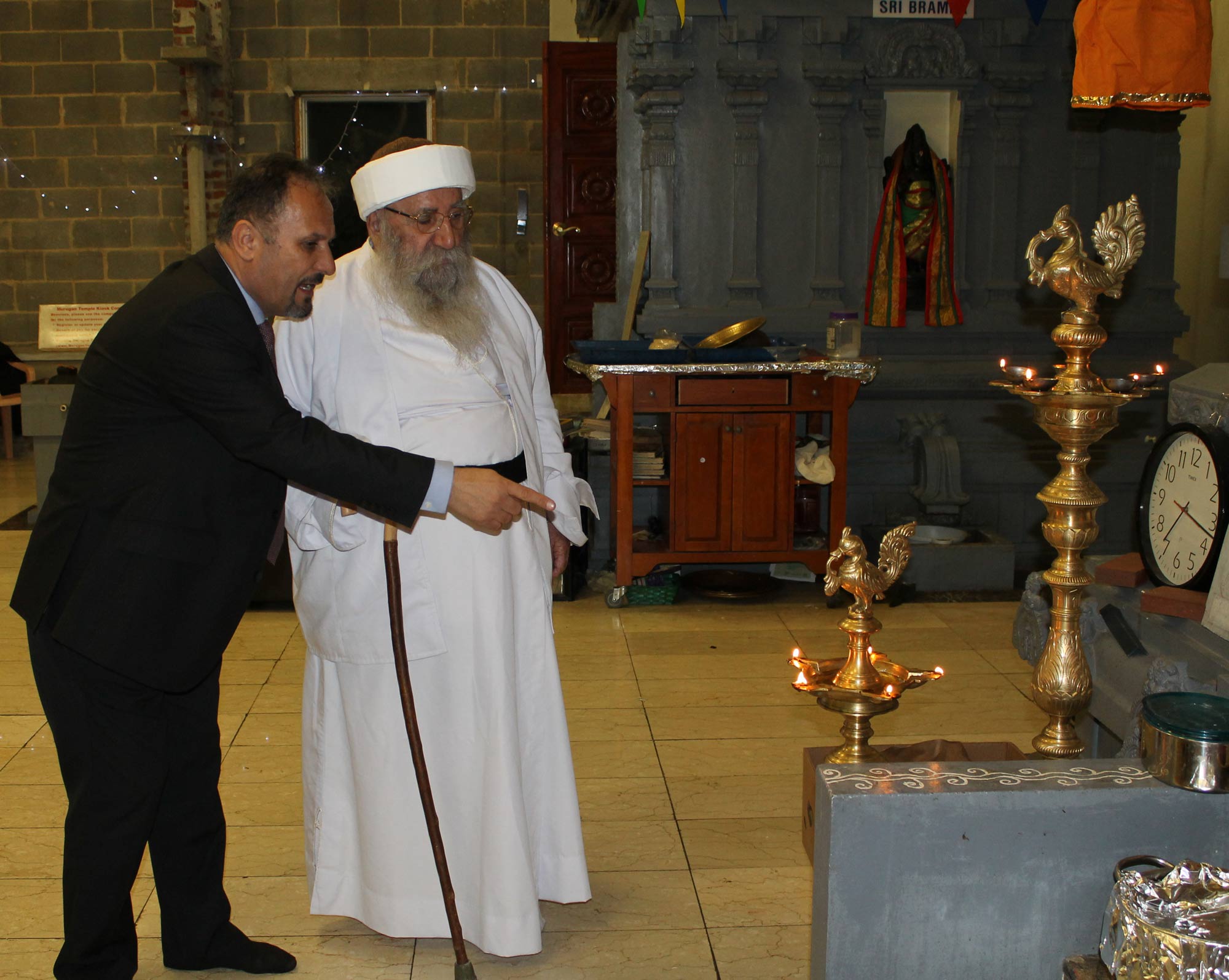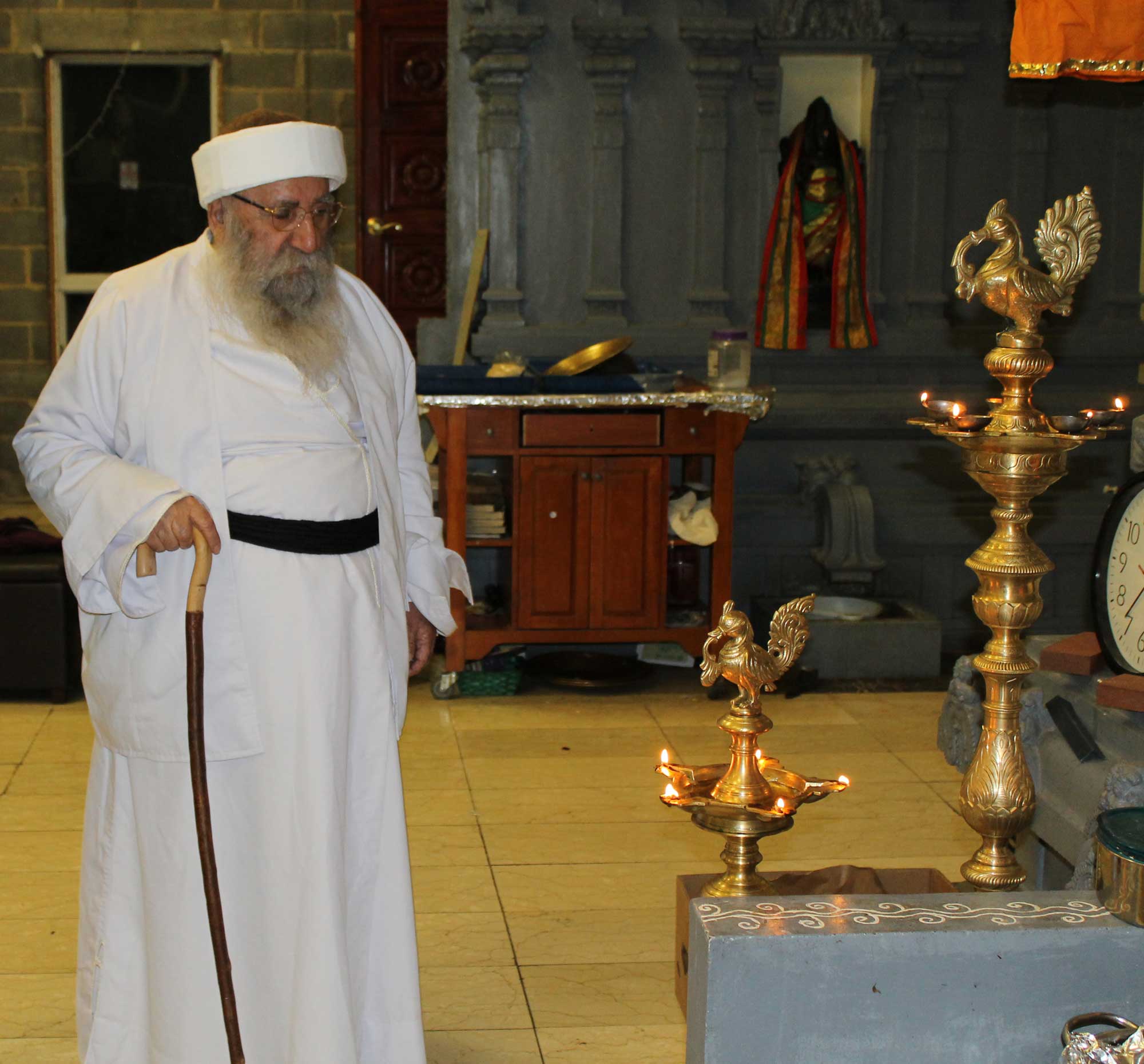Yezidis and Hindus make common cause under ‘Peacock Angel’
Yezidi Baba Sheikh at Washington DC Murugan Temple
Article and photos by Patrick Harrigan
The Baba Sheikh, spiritual leader of the ancient Yezidi religious community of northern Iraq, visits Washington DC seeking support from the US Government—and from Hindu war god Skanda Murugan at the Murugan Temple of North America on 29 October 2014, during the climax of Skanda Sashti when Skanda vanquishes demonic forces threatening humanity.
(Washington DC) A delegation of top Yezidi spiritual and political leaders visited Washington DC October 24-31 seeking support for their threatened minority and sacred sites in northern Iraq that are currently surrounded by ISIS fighters, who aim to ‘cleanse the Islamic State’ of any trace of the ‘pagan’ ancient religious minority who worship Melek Ta’us, the ‘Peacock Angel’.
In a deeply symbolic act, the Baba Sheikh, spiritual leader of the Yezidis, visited the Washington temple of the pan-Indian war god Skanda-Murugan on October 29 to witness Soora Samhāram, the ritual conclusion of Skanda Sashti, ‘Skanda’s Six-Day War’ against demonic forces threatening the earth. It was the first time ever that the Yezidi spiritual leadership visited a temple of the peacock-mounted war god of India, whom Yezidis identify with Melek Ta’us, the ‘Peacock Angel’ whom they consider to be God’s regent on earth.
In the Yezidi faith, Melek Ta’us is regarded as the foremost among archangels and an emanation of God Himself. Yezidi religion is centered upon Melek Ta’us, who is depicted as a peacock. Peacocks, however, are not native to the lands where Melek Ta’us is worshipped, but to the Indian subcontinent.
According to their own oral traditions, Yezidis once lived in India thousands of years ago. Yezidis, moreover, still preserve a system of four castes that do not intermarry. And they also believe in karma and rebirth, which are core tenets of Hindu Dharma.
According to the Yezidi calendar, it is currently the year 6,764. Scholars of religion concede that the Yezidi faith has absorbed and preserved many elements from ancient faiths including Sanatana Dharma, Mithraism, and Zoroastrianism, as well as the influence of Sufis or Islamic mystics—all targets of hardline ISIS fundamentalism.
“The Yezidis are a very special religious community because they’re one of the only remaining religions in the Middle East with non-Abrahamic origins,” says Matthew Barber, a scholar at the University of Chicago’s Department of Near Eastern Languages and Civilizations.
“The Yezidi religion has absorbed elements from many religious traditions in the Near East, but within their religious framework are preserved some very ancient beliefs that no longer survive in any other religion. The reason that ISIS attacks the Yezidi community in this way is because they view them as pagan and polytheistic because they’re outside of the Abrahamic religions that have a written scripture.”
The Baba Sheikh and his entourage evinced a keen interest in the Hindu war god’s associations with the peacock. They were astonished to see tall standing brass oil lamps surmounted by peacocks, identical to the sanjaks or brass peacock lamps that play a central role in one of the most important events of the Yezidi New Year—the ‘Parade of the Sanjaks’ or ‘Parade of the Peacock’.
The war god Skanda Kumara was among North India’s most popular deities during the Classical Age in the first millennium of the Common Era. He remains extremely popular in South India, Sri Lanka, Malaysia and worldwide among the Tamil Hindu diaspora where he is known as Murugan, the ‘tender youth’ associated with poetry, love, and war.
The Baba Sheikh blessed Hindus who were observing the Skanda Sashti Soora Samhāram at the Washington temple, He remarked to them that this startling confluence of Yezidi and Hindu worship was also happening on a Wednesday, which is the Sabbath day of the Yezidis.
The Baba Sheikh urged listeners to strive for peace worldwide and not to descend into bigotry and intolerance that are the hallmarks of religious fundamentalism. Hindus and Yezidis alike marveled at the uncanny convergence of two ancient faiths on Skanda Sashti, and all prayed that their Lord of the Peacock would answer the fervent prayers of Yezidis in Iraq and worldwide.
The author is an American indologist specializing since 1972 in the Sri Lankan shrine Kataragama, regarded as sacred by the island’s Hindu, Buddhist, Muslim, and indigenous communities.
Suggested photo captions—photos by Patrick Harrigan
IMG_6485: The Baba Sheikh, spiritual leader of the Yezidis, visited the Washington DC temple of the pan-Indian war god Skanda-Murugan on October 29, 2014.
IMG_6491: The sanjak or brass peacock lamp plays a central role in Yezidi tradition. The Baba Sheikh and his entourage were astonished to see such large sanjaks in the Murugan temple.
IMG_6492: The sanjak or brass peacock lamp plays a central role in Yezidi tradition. The Baba Sheikh and his entourage were astonished to see such large sanjaks in the Murugan temple.
IMG_6493: The sanjak or brass peacock lamp plays a central role in Yezidi tradition. The Baba Sheikh and his entourage were astonished to see such large sanjaks in the Murugan temple.
IMG_6513: The Yezidis witnessed Soora Samhāram, the ritual conclusion of ‘Skanda’s Six-Day War’, after which gurukkals poured milk libation over Lord Murugan to cool His wrath.
IMG_6536: After witnessing the Soora Samhāram or ritual destruction of demonic forces, the Baba Sheikh accepted prasādam that had been offered to Lord Skanda-Murugan.
Other Images
Baba Sheikh-tilak-child: The Baba Sheikh, spiritual leader of the Yezidis, blesses a child with a tilak-like application to the forehead, as is also the practice by Hindus.
Yazidi – peacock – Hindu Subrahmanya:
Yazidi children at their holiest site, Lalish Temple: Yezidis, like Hindus, are greatly concerned with ritual purity of body, mind, and soul. Pilgrims to Lalish wear white out of humility and respect.
Yazidi-emblem-Taus-Melik: The emblem of Melek Ta’us, the ‘Peacock Angel’ of Yezidi faith
Yezidis worship sanjak or peacock lamp in Armenia: Yezidis revere the sanjak or peacock lamp, which in the Yezidi faith representsMelek Ta’us the Peacock Angel.
Source: WHN Media Network
Disclaimer: The opinions expressed within this article are the personal opinions of the author. World Hindu News is not responsible for the accuracy, completeness, suitability, or validity of any information on this article. All information is provided on an as-is basis. The information, facts or opinions appearing in the article do not reflect the views of World Hindu News and World Hindu News does not assume any responsibility or liability for the same.















